Finding the best piano stand is often overlooked even though it is equally important for the performer’s comfort and stability during a live performance, daily practice, or home studio recording sessions. The right stand enhances playability while also preserving the instrument’s integrity. In this article, we address the most prevalent questions to assist users in making sound decisions.
Learn more from, The History of Piano Stands: From Grand Pianos to 2025’s Digital Innovations
Helpful Tips for Finding the Best Stand for Electronic Pianos
What features need to be taken into account when selecting a piano stand?
The user’s intent regarding the stand’s purpose, along with the instrument’s dimensions, weight, and intended use, are all essential factors. For digital pianos, an easy-to-use portable keyboard might have a mounting bracket or screwdriver’s attachment systems, and all requirements, including foldable designs, must be portable. However, having an overly loose fit should be avoided, so it is essential to check the manufacturer’s weight limit.
Are There Any Stands That Correspond With Specific Piano Brands Or Models?
In the example of keyboards, slab-style digital pianos come with bolt on stands for greater security. Certain brands have specialized stands that are tailored to go along with their specific instruments. Other models are more suitably designed for universal stands that feature adjustable width settings.
Issues with Stability and Durability
In what ways can the stability of a piano stand’s assistance be evaluated?
Stability can be confirmed in advance by asking if the piano pad has wide feet or rubber grips. When the stand is put together, it is possible to exert a gentle force to see if it shifts. Crossbars, heavy-duty secure clamps or bolted joints indicate good construction and provide lasting stability.
What suggested materials will withstand long usage?
The materials should be long-lasting and include a frame of steel or aluminum because they have a high strength-to-weight ratio, increased structural integrity, and optimized endurance.
Portability and Storage Solutions
Who would benefit the most from frequent traveling with Stand-Aid?
Due to their lightweight and foldable design, they would be the best stand for those who have traveling needs. During transport, disassembled parts can be stored in carrying bags or cases.
Can a piano stand be disassembled without tools?
Most modern stands nowadays come with tool-free assembly systems like snap locks and quick-release clamps. Bolt-on models, however, may require basic tools for some of their installation.
Adjustability and Functional Parts
How crucial is height adjustment in playing posture?
With an increase in ergonomic level, propping elbows allows the keyboard to be positioned higher for ease of access. Fixed-height models often require extra steps geared towards top seating alignment.
Are Angled Stands Better for Certain Playing Styles?
Because of visibility and the traditional piano feel, performers prefer angled stands such as Z-style designs. However, these may take up more floor space than flat configurations.
Aesthetic and Functional Accessories
Can a piano stand be customized to match a room’s decor?
Stands with a woodgrain finish or minimalist design can blend into living spaces seamlessly. Other removable parts like music racks or pedal mounts also serve the purpose of adding functionality without compromising aesthetic appeal.
Are third-party accessories compatible with most stands?
Most stands can be fitted with accessories such as microphone holders or tablet stands using universal clamps or adapters. However, verification with the stand’s dimensions and weight limits will dictate whether they are compatible.
Safety and Maintenance Tips
What precautions prevent a piano stand from tipping over?
To reduce the chance of a piano stand tipping over, the piano must be centered on the stand with weight evenly distributed across the surface. For heavier instruments, anti-tip straps or wall anchors can be helpful. Performances on uneven surfaces should also be avoided.
How frequently should component hardware be checked?
The screws, bolts, and joints of the stand must be checked every 3–6 months depending on usage. If worn rubber feet or loose brackets are present, they must be replaced to ensure stability.
Conclusion
Regardless of the skill level, choosing a piano stand can be daunting, whether it is a beginner’s first keyboard or a professional’s stage setup. On Stage, 5 Core makes highly adaptable and durable keyboard stands that are great for professionals and beginners alike. Roland is also known for making top-quality seamless stands that integrate with their digital pianos. With the answers to these questions, users can guarantee the upkeep of security, accessibility, and functionality of their instruments during any performance.



